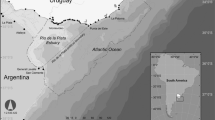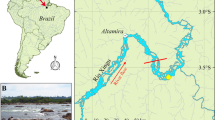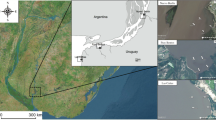Abstract
Quantification of key pathways sustaining ecosystem function is critical for underpinning informed decisions on development approvals, zoning and offsets, ecosystem restoration and for meaningful environmental assessments and monitoring. To develop a more quantitative understanding of the importance and variation in food webs and nutrient flows in tropical estuaries, we investigated the spatio-temporal distribution of biomass of fish across 28 mangrove-lined estuaries in tropical Australia. We evaluated the extent to which nekton biomass in tropical estuaries responded to spatial and temporal factors and to trophic identity. Biomass was dominated by two trophic groups, planktivores and macrobenthos feeders. Contributions by other trophic groups, such as detritivores and microbenthos feeders, were more variable. Total biomass and the biomass of all major trophic groups were concentrated in downstream reaches of estuaries. The consistent concentration of biomass downstream, and spatio-temporal differences in the contributions by the different trophic groups, indicates substantial differences in food web structure, differences in the contributions from different sources of nutrition and probably unequal flow of productivity into higher levels of the food web in different parts of the estuary. In turn, this suggests substantial qualitative and quantitative differences in ecosystem-supporting processes in different estuary reaches.






Similar content being viewed by others
References
Abrantes, K., and M. Sheaves. 2009. Food web structure in a near-pristine mangrove area of the Australian wet tropics. Estuarine Coastal and Shelf Science 82: 597–607.
Abrantes, K., and M. Sheaves. 2010. Importance of freshwater flow in terrestrial-aquatic energetic conectivity in intermittently connected estuaries of tropical Australia. Marine Biology 157: 2071–2086.
Abrantes, K., A. Barnett, R. Baker, and M. Sheaves. 2015. Habitat-specific food webs and trophic interactions supporting coastal-dependent fishery species: an Australian case study. Reviews in Fish Biology and Fisheries 25: 337–363.
Antonio, E.S., A. Kasai, M. Ueno, N. Won, Y. Ishihi, H. Yokoyama, and Y. Yamashita. 2010. Spatial variation in organic matter utilization by benthic communities from Yura River-estuary to offshore of Tango Sea, Japan. Estuarine Coastal and Shelf Science 86: 107–117.
Baker, R., and T.J. Minello. 2011. Trade-offs between gear selectivity and logistics when sampling nekton from shallow open water habitats: a gear comparison study. Gulf and Caribbean Research 23: 37–48.
Baker, R., and M. Sheaves. 2005. Redefining the piscivore assemblage of shallow estuarine nursery habitats. Marine Ecology-Progress Series 291: 197–213.
Baker, R., B. Fry, L.P. Rozas, and T.J. Minello. 2013. Hydrodynamic regulation of salt marsh contributions to aquatic food webs. Marine Ecology Progress Series 490: 37–52.
Baker, R., A. Buckland, and M. Sheaves. 2014. Fish gut content analysis: robust measures of diet composition. Fish and Fisheries 15: 170–177.
Beger, M., H.S. Grantham, R.L. Pressey, K.A. Wilson, E.L. Peterson, D. Dorfman, P.J. Mumby, R. Lourival, D.R. Brumbaugh, and H.P. Possingham. 2010. Conservation planning for connectivity across marine, freshwater, and terrestrial realms. Biological Conservation 143: 565–575.
Bergamino, L., D. Lercari, and O. Defeo. 2011. Food web structure of sandy beaches: temporal and spatial variation using stable isotope analysis. Estuarine, Coastal and Shelf Science 91: 536–543.
Bergamino, L., J. Gomez, F.R. Barboza, and D. Lercari. 2013. Major food web properties of two sandy beaches with contrasting morphodynamics, and effects on the stability. Aquatic Ecology 47: 253–261.
Blaber, S.J.M., and D.A. Milton. 1990. Species composition, community structure and zoogeography of fishes of mangrove estuaries in the Solomon Islands. Marine biology, Heidelberg 105: 259–267.
Blaber, S.J.M., D.T. Brewer, and J.P. Salini. 1989. Species composition and biomasses of fishes in different habitats of a tropical northern Australian estuary: their occurrence in the adjoining sea and estuarine dependence. Estuarine, Coastal and Shelf Science 29: 509–531.
Breiman, L., J. Friedman, R. Olshen, and C. Stone. 1984. Classification and regression trees. Belmont: Wadsworth Internation Group.
Burghart, S.E., D.L. Jones, and E.B. Peebles. 2013. Variation in estuarine consumer communities along an assembled eutrophication gradient: implications for trophic instability. Estuaries and Coasts 36: 951–965.
Choi, Y., and Y. Wang. 2004. Dynamics of carbon sequestration in a coastal wetland using radiocarbon measurements. Global Biogeochemical Cycles 18: [np].
Claudino, M.C., P.C. Abreu, and A.M. Garcia. 2013. Stable isotopes reveal temporal and between-habitat changes in trophic pathways in a southwestern Atlantic estuary. Marine Ecology Progress Series 489: 29–42.
Coles, R.G., M.A. Rasheed, L.J. McKenzie, A. Grech, P.H. York, M. Sheaves, S. McKenna, and C. Bryant. 2015. The great barrier reef world heritage area seagrasses: managing this iconic Australian ecosystem resource for the future. Estuarine, Coastal and Shelf Science 153: A1–A12.
Corn, M., and C. Copeland. 2010. The Deepwater Horizon oil spill: coastal wetland and wildlife impacts and response. In CRS Report for Congress, 24: Congressional Research Service.
Costanza, R., R. d’Arge, R. de Groot, S. Farber, M. Grasso, B. Hannon, K. Limburg, S. Naeem, R. O’Neill, J. Paruelo, R. Raskin, P. Sutton, and M. van den Belt. 1997. The value of the world’s ecosystem services and natural capital. Nature 387: 253–260.
Cowley, P., and A. Whitfield. 2002. Biomass and production estimates of a fish community in a small south African estuary. Journal of Fish Biology 61: 74–89.
Creighton, C., P. Boon, J. Brookes, and M. Sheaves. 2015. Repairing Australia’s estuaries for improved fisheries production—what benefits, at what cost? Marine and Freshwater Research.
De’ath, G. 2002. Multivariate regression trees: a new technique for modeling species-environment relationships. Ecology 83: 1105–1117.
De’ath, G., and K.E. Fabricius. 2000. Classification and regression trees: a powerful yet simple technique for ecological data analysis. Ecology 81: 3178–3192.
Duke, N.C., J.O. Meynecke, S. Dittmann, A.M. Ellison, K. Anger, U. Berger, S. Cannicci, K. Diele, K.C. Ewel, C.D. Field, N. Koedam, S.Y. Lee, C. Marchand, I. Nordhaus, and F. Dahdouh-Guebas. 2007. A world without mangroves? Science 317: 41–42.
Dutra, L.X., R.H. Bustamante, I. Sporne, I. van Putten, C.M. Dichmont, E. Ligtermoet, M. Sheaves, and R.A. Deng. 2015. Organizational drivers that strengthen adaptive capacity in the coastal zone of Australia. Ocean & Coastal Management 109: 64–76.
Eamus, D., C.M.O. Macinnis-Ng, G.C. Hose, M.J.B. Zeppel, D.T. Taylor, and B.R. Murray. 2005. Ecosystem services: an ecophysiological examination. Australian Journal of Botany 53: 1–19.
Edgar, G.J., N.S. Barrett, D.J. Graddon, and P.R. Last. 2000. The conservation significance of estuaries: a classification of Tasmanian estuaries using ecological, physical and demographic attributes as a case study. Biological Conservation 92: 383–397.
Elliott, M., and V. Quintino. 2007. The estuarine quality paradox, environmental homeostasis and the difficulty of detecting anthropogenic stress in naturally stressed areas. Marine Pollution Bulletin 54: 640–645.
Elliott, M., A.K. Whitfield, I.C. Potter, S.J. Blaber, D.P. Cyrus, F.G. Nordlie, and T.D. Harrison. 2007. The guild approach to categorizing estuarine fish assemblages: a global review. Fish and Fisheries 8: 241–268.
Erwin, K.L. 2009. Wetlands and global climate change: the role of wetland restoration in a changing world. Wetlands Ecology and Management 17: 71–84.
Gehrke, P.C., M.J. Sheaves, D. Boseto, B.S. Figa, and J. Wani. 2011. Vulnerability of freshwater and estuarine fisheries in the tropical Pacific to climate change. Vulnerability of Tropical Pacific Fisheries and Aquaculture to Climate Change. Secretariat of the Pacific Community, Noumea, New Caledonia: 577–645.
Grech, A., M. Bos, J. Brodie, R. Coles, A. Dale, R. Gilbert, M. Hamann, H. Marsh, K. Neil, R. Pressey, M. Rasheed, M. Sheaves, and A. Smith. 2013. Guiding principles for the improved governance of port and shipping impacts in the great barrier reef. Marine Pollution Bulletin 75: 8–20.
Harrison, T.D. 2005. Ichthyofauna of South African estuaries in relation to the zoogeography of the region. Smithiana Bulletin: 1–27.
Harrison, T., and A. Whitfield. 2008. Geographical and typological changes in fish guilds of south African estuaries. Journal of Fish Biology 73: 2542–2570.
Harrison, T., and A. Whitfield. 2012. Fish trophic structure in estuaries, with particular emphasis on estuarine typology and zoogeography. Journal of Fish Biology 81: 2005–2029.
Jennings, S., K.J. Warr, and S. Mackinson. 2002. Use of size-based production and stable isotope analyses to predict trophic transfer efficiencies and predator-prey body mass ratios in food webs. Marine Ecology Progress Series 240: 11–20.
Kent, J. 2007. Spatial and temporal variation in diet and feeding habits of zooplanktivorous fish in tropical North Queensland estuaries. James Cook University Townsville.
Kostecki, C., F. Le Loc’h, J.-M. Roussel, N. Desroy, D. Huteau, P. Riera, H. Le Bris, and O. Le Pape. 2010. Dynamics of an estuarine nursery ground: the spatio-temporal relationship between the river flow and the food web of the juvenile common sole (Solea solea, L.) as revealed by stable isotopes analysis. Journal of Sea Research 64: 54–60.
Lotze, H.K., H.S. Lenihan, B.J. Bourque, R.H. Bradbury, R.G. Cooke, M.C. Kay, S.M. Kidwell, M.X. Kirby, C.H. Peterson, and J.B.C. Jackson. 2006. Depletion, degradation, and recovery potential of estuaries and coastal seas. Science 312: 1806–1809.
Marczak, L.B., R.M. Thompson, and J.S. Richardson. 2007. Meta-analysis: trophic level, habitat, and productivity shape the food web effects of resource subsidies. Ecology 88: 140–148.
Marshall, S., and M. Elliott. 1998. Environmental influences on the fish assemblage of the Humber estuary, UK. Estuarine, Coastal and Shelf Science 46: 175–184.
Nagelkerken, I., M. Sheaves, R. Baker, and R.M. Connolly. 2015. The seascape nursery: a novel spatial approach to identify and manage nurseries for coastal marine fauna. Fish and Fisheries 16: 362–371.
Olin, J.A., S.A. Rush, M.A. MacNeil, and A.T. Fisk. 2012. Isotopic ratios reveal mixed seasonal variation among fishes from two subtropical estuarine systems. Estuaries and Coasts 35: 811–820.
Orrock, J.L., J.H. Grabowski, J.H. Pantel, S.D. Peacor, B.L. Peckarsky, A. Sih, and E.E. Werner. 2008. Consumptive and nonconsumptive effects of predators on metacommunities of competing prey. Ecology 89: 2426–2435.
Pasquaud, S., V. David, J. Lobry, M. Girardin, B. Sautour, and P. Elie. 2010. Exploitation of trophic resources by fish under stressful estuarine conditions. Marine Ecology Progress Series 400: 207–219.
Polis, G.A. 1999. Why are parts of the world green? Multiple factors control productivity and the distribution of biomass. Oikos: 3–15.
Polis, G.A., and D.R. Strong. 1996. Food web complexity and community dynamics. American Naturalist: 813–846.
Prado, P., C. Ibanez, N. Caiola, and E. Reyes. 2013. Evaluation of seasonal variability in the food-web properties of coastal lagoons subjected to contrasting salinity gradients using network analyses. Ecological Modelling 265: 180–193.
Rozas, L.P., and T.J. Minello. 1997. Estimating densities of small fishes and decapod crustaceans in shallow estuarine habitats: a review of sampling design with focus on gear selection. Estuaries 20: 199–213.
Salini, J.P., S.J.M. Blaber, and D.T. Brewer. 1990. Diets of piscivorous fishes in a tropical Australian estuary, with special reference to predation on penaeid prawns. Marine biology, Heidelberg 105: 363–374.
Salini, J.P., D.T. Brewer, and S.J.M. Blaber. 1998. Dietary studies on the predatory fishes of the Norman River Estuary, with particular reference to penaeid prawns. Estuarine, Coastal and Shelf Science [Estuar. Coast. Shelf Sci.] 46: 837–847.
Sheaves, M. 2016. Simple processes drive unpredictable differences in estuarine fish assemblages: baselines for understanding site-specific ecological and anthropogenic impacts. Estuarine, Coastal and Shelf Science 170: 61–69.
Sheaves, M., and R. Johnston. 2008. Influence of marine and freshwater connectivity on the dynamics of subtropical estuarine wetland fish metapopulations. Marine Ecology-Progress Series 357: 225–243.
Sheaves, M., and R. Johnston. 2009. Ecological drivers of spatial variability among fish fauna of 21 tropical Australian estuaries. Marine Ecology-Progress Series 385: 245–260.
Sheaves, M., R. Johnston, and R.M. Connolly. 2010. Temporal dynamics of fish assemblages of natural and artificial tropical estuaries. Marine Ecology-Progress Series 410: 143–156.
Sheaves, M., J. Brookes, R. Coles, M. Freckelton, P. Groves, R. Johnston, and P. Winberg. 2014. Repair and revitalisation of Australia’s tropical estuaries and coastal wetlands: opportunities and constraints for the reinstatement of lost function and productivity. Marine Policy 47: 23–36.
Sheaves, M., R. Baker, I. Nagelkerken, and R.M. Connolly. 2015. True value of estuarine and coastal nurseries for fish: incorporating complexity and dynamics. Estuaries and Coasts 38: 401–414.
Teal, J.M., and M.P. Weinstein. 2002. Ecological engineering, design, and construction considerations for marsh restorations in Delaware Bay, USA. Ecological Engineering 18: 607–618.
Thorp, J.H., M.C. Thoms, and M.D. Delong. 2006. The riverine ecosystem synthesis: biocomplexity in river networks across space and time. River Research and Applications 22: 123–147.
Vitousek, P., H. Mooney, J. Lubchenco, and J. Melillo. 1997. Human domination of Earth’s ecosystems. Science 277: 494–499.
Walters, C., S.J. Martell, V. Christensen, and B. Mahmoudi. 2008. An Ecosim model for exploring Gulf of Mexico ecosystem management options: implications of including multistanza life-history models for policy predictions. Bulletin of Marine Science 83: 251–271.
Weinstein, M., and S. Litvin. 2016. Macro-restoration of tidal wetlands: a whole estuary approach. Ecological Restoration 34.
Wilson, J.P., and M. Sheaves. 2001. Short-term temporal variations in taxonomic composition and trophic structure of a tropical estuarine fish assemblage. Marine Biology 139: 787–796.
Zimmerman, R.J., T.J. Minello, and G. Zamora. 1984. Selection of vegetated habitat by brown shrimp, Penaeus aztecus, in a Galveston Bay salt marsh. Fishery Bulletin 82: 325–336.
Acknowledgments
Conflict of interest The authors declare that they have no conflict of interest. This project was supported by a grant from the Marine and Tropical Sciences Research Facility. We thank Ross Johnston and the many field volunteers whose assistance made the extensive field work possible.
Author information
Authors and Affiliations
Corresponding author
Additional information
Communicated by Nadine A. Strydom
Electronic supplementary material
ESM 1
(PDF 148 kb)
Rights and permissions
About this article
Cite this article
Sheaves, M., Baker, R., Abrantes, K.G. et al. Fish Biomass in Tropical Estuaries: Substantial Variation in Food Web Structure, Sources of Nutrition and Ecosystem-Supporting Processes. Estuaries and Coasts 40, 580–593 (2017). https://doi.org/10.1007/s12237-016-0159-0
Received:
Revised:
Accepted:
Published:
Issue Date:
DOI: https://doi.org/10.1007/s12237-016-0159-0




